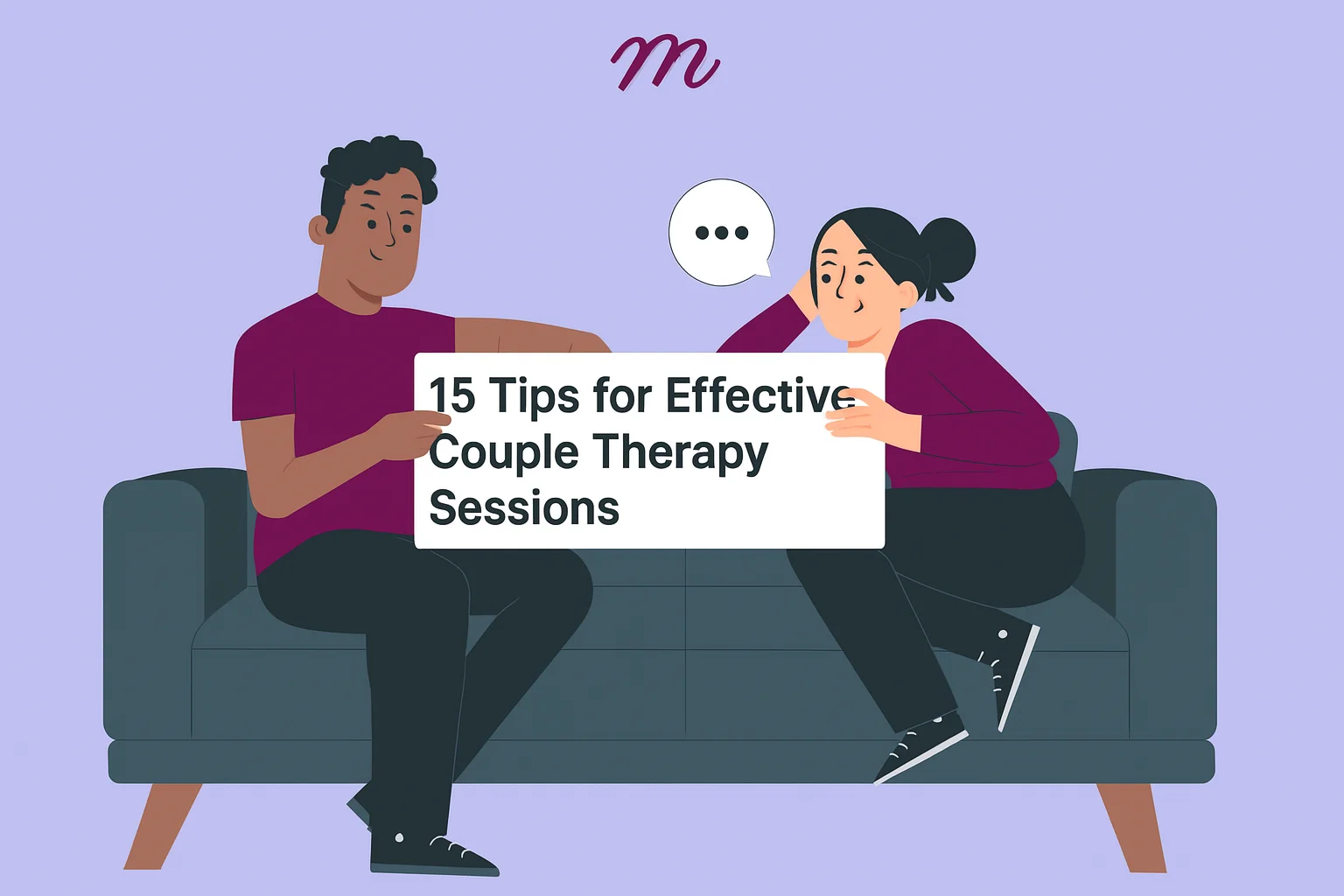Couple therapy sessions are different compared to individual therapy sessions. Therapists have to handle the complex back-and-forth between partners while staying neutral and making sure everyone feels safe enough to be vulnerable. New therapists often find nothing in grad school that prepares them for how intense these sessions can get or how complicated the patterns are when two people bring their relationship issues into the room.
The couples who walk through the door aren’t thinking about attachment theory or research studies. They’re just drowning and need someone to throw them a lifeline without getting pulled under too. These tips come from both textbooks and from the messy, beautiful reality of sitting with real couples in real pain.
Understanding the Goals of Couple Therapy Sessions
Effective couple therapy sessions begin with clear goals that both partners understand and commit to. While each relationship has unique needs, most couples therapy sessions aim to:
- Improve communication patterns and reduce destructive interactions
- Increase emotional intimacy and connection
- Develop conflict resolution skills that work for both partners
- Address specific relationship challenges (parenting differences, financial conflicts)
- Heal from relationship injuries such as betrayal or neglect
- Create a shared vision for the relationship’s future
Success in couples therapy isn’t always measured by whether the relationship continues. Sometimes, the healthiest outcome is a mindful separation. The ultimate goal is helping both individuals achieve greater relational health, whether together or apart.
Ground Rules for Couple Therapy Sessions
Establishing and maintaining clear boundaries creates the safety necessary for vulnerable therapeutic work. Essential ground rules include:
- No interrupting when a partner is speaking
- No name-calling or contemptuous language
- No threatening divorce or separation as a debate tactic
- Equal speaking time for both partners
- Commitment to attending sessions regularly
- Completion of agreed-upon homework between sessions
When these boundaries are crossed, immediate intervention is necessary. Some couples need additional structure, such as using talking objects—only the person holding the designated item may speak. These boundaries aren’t punitive—they’re protective, creating the safety necessary for vulnerability to emerge.
Use Evidence-Based Frameworks (e.g., Gottman, EFT, IMAGO)
Good couple therapy sessions use approaches that actually work. These evidence-based frameworks give therapists a proven roadmap:
Helps couples build friendship, manage conflict, and create shared meaning. Dr. John Gottman identified the “Four Horsemen” that predict relationship breakdown: criticism, contempt, defensiveness, and stonewalling. When these show up, therapists help couples replace them with healthier communication patterns.
2. Emotionally Focused Therapy (EFT)
Views relationship distress through the lens of attachment theory. Dr. Sue Johnson’s EFT helps couples recognize their negative interaction cycles, access vulnerable emotions underneath, and strengthen emotional bonds. Many couples repeat the same fights — EFT helps them understand and change those patterns.
5. IMAGO Relationship Therapy
Connects current relationship struggles to early childhood experiences. Created by Harville Hendrix and Helen LaKelly Hunt, it uses structured dialogues to help couples transform conflict into opportunities for growth and healing. Surprisingly often, we’re drawn to partners who trigger unresolved wounds — IMAGO helps couples work through them.
4. Narrative Therapy
Helps couples externalize problems — seeing the issue as something separate from the people involved. Instead of “You’re controlling,” it becomes “How is this control issue affecting us?” This shift allows couples to re-author their relationship story in a more constructive, collaborative way.
Couple Therapy Sessions Outline
A clear structure provides safety and direction for productive therapeutic work:
- Check-in (5-10 minutes): Review the previous week, if they completed the homework, and any significant events since the last session.
- Agenda setting (5 minutes): Determine the focus of the session based on immediate needs or ongoing issues.
- Core work (30-40 minutes): Address the identified issue through appropriate interventions, communication exercises, exploring underlying emotions, or processing relationship patterns.
- Integration and homework assignment (5-10 minutes): Summarize insights gained and assign specific homework to reinforce session work.
- Closing (5 minutes): End with acknowledgment of progress and clarification of next steps.
This consistent structure helps couples understand what to expect and creates containment for potentially difficult emotional work.
15 Tips for Effective Couple Therapy Sessions
1. Begin with a Clear Framework
My early couple therapy sessions were chaotic, impossible to organize, and ultimately kind of useless. Now I never start without laying out exactly how it is going to work.
“Here’s how these sessions are,” I tell them on day one. “First, we’ll figure out your story—how you got here. Then we’ll identify the patterns that keep tripping you up. Finally, we’ll practice specific skills to change those patterns.”
It’s amazing how structure creates safety for all of us. Without it, sessions spiral into blame-fests where nobody feels heard and everyone leaves more wounded than when they arrived.
Sometimes I use the dance metaphor: “Think of couple therapy sessions as learning a new way to dance together. You’ll step on each other’s toes. You’ll forget the steps. That’s normal. My job is to be your choreographer, not your judge.”
2. Assess for Safety First
This is something that my supervisor warned me about. She nearly missed it with a couple. They seemed perfect—articulate, committed, willing to do the work. Six sessions in, she called from her sister’s house. He had thrown a lamp across the room after they’d discussed something from therapy.
I screen thoroughly before diving into deeper work. Not just for physical violence—emotional safety matters too. Does criticism morph into contempt at home? Does disagreement lead to days of silent treatment? These dynamics must be addressed before any meaningful work can happen.
I’ll “accidentally” run long with one partner while the other’s in the waiting room. “Is there anything you haven’t felt safe sharing when your partner’s present?” The looks I get in response tell me everything.
The hardest part? When I have to say, “I don’t think conjoint therapy is appropriate right now.” But I’ve never regretted prioritizing safety over keeping couples together at any cost.
3. Balance Airtime Intentionally
Even if the clients don’t realize it, while they are discussing, I keep track of how much each one is talking, even making notes about it.
When one consistently takes 80% of our time, it’s not an accident. It’s a dynamic that plays out at home too, where his partner’s voice grows progressively smaller until it disappears entirely.
“Peter, I need to interrupt you here,” I’ll say. “John hasn’t had a chance to respond to what happened yesterday.” His surprised expression says it all—he genuinely doesn’t notice the imbalance.
I pay special attention when one partner has professional communication skills—like therapists or lawyers. Their articulate arguments sound reasonable but can steamroll a less verbally dexterous partner whose simpler “I just feel bad” might actually contain the key to the whole situation.
4. Use Circular Questions to Shift Perspective
“Rob, what do you think goes through Tanya’s mind when you check your phone during dinner?”
The question stops him cold. He’s spent our sessions explaining why his phone use is reasonable—work demands, brief glances, her overreaction. He’s never once considered her subjective experience.
“I… I don’t know,” he admits.
Circular questions are magic that way. They invite each partner to step into the other’s reality without having to agree with it. They interrupt rigid thinking where each person is absolutely convinced their perspective is the only truth.
I use them especially when couples are stuck: “On a scale of 1-10, how hopeful are you that things can improve? Now, what number would your partner give?” The gap between their answers often reveals more than hours of direct questioning.
5. Track and Name Interaction Patterns
Couples locked in these patterns can’t see them from the inside. They’re too busy reacting, defending, and hurting. My job is to pull back the camera and show them the whole dance, not just their individual steps.
With Teresa and Kim, we drew their conflict pattern on my whiteboard. Two weeks later, Kim texted me, “We were doing the thing on the whiteboard, but we caught it halfway through!” Those moments of metacommunication—when they can observe their pattern instead of being trapped in it—that’s where change begins.
6. Translate Between Different Emotional Languages
Mel and Jordan nearly divorced over dirty dishes. Not really, of course—it was never about dishes. Mel saw unwashed plates as evidence Jordan didn’t care about their shared space or, by extension, about Mel. Jordan saw Mel’s anger as controlling and critical, triggering childhood memories of never being good enough.
Same event, completely different emotional languages.
“Jordan, when you leave dishes in the sink, it doesn’t just register to Mel as a chore undone,” I explained once we had really hit the ground running. “In Mel’s emotional language, it feels like a message that says ‘I don’t care about your needs.’”
Then to Mel: “When you express frustration about the dishes, Jordan doesn’t hear ‘I wish you’d help more.’ In Jordan’s emotional language, it sounds like ‘You’re fundamentally disappointing as a person.’”
This translation work feels simplistic sometimes, almost silly, but it’s astonishing how many couples have never truly understood the emotional coding beneath their partner’s words and actions.
7. Slow Down Escalating Interactions
I learned this from a couple who went from zero to nuclear in sixty seconds. By the time they reached my office, their fight response was so well-rehearsed that a single trigger word could send them into a huge argument.
“Let’s all take a breath,” I’ll say, physically demonstrating a deep inhale. Sometimes I’ll have them place their feet firmly on the floor and notice three things they can see in the room. Simple grounding techniques.
With particularly volatile couples, I’ll use a visual cue—raising my hand like a traffic cop. We practice what to do when they see this signal: pause, breathe, lower their voice. Eventually they learn to recognize their own escalation cues and self-regulate before reaching the point of no return.
8. Focus on Underlying Vulnerabilities, Not Surface Conflicts
“He spends too much money” becomes a very different conversation when we discover he feels insecure when he doesn’t. “She works too much” transforms when we learn that his mother’s emotional absence taught him that he’d always be a last priority.
Present conflicts are important, but the roots have to be explored to understand what’s really at stake. The arguments that play on repeat in couples’ relationships—money, sex, kids, chores—are rarely about the surface issue. They’re coded conversations about deeper needs and fears that neither person has found words for.
When they could say “I’m scared of not being valued” instead of “You never help,” and “I feel like I can’t get anything right” instead of “You’re always nagging me,” real healing became possible.
9. Establish and Enforce Session Boundaries
My first supervisor watched me struggle with a hostile couple and said, “Your therapy room has to be comfortable for you as well.” That changed everything for me.
Now I start with clear boundaries: no interrupting, no name-calling, no threatening divorce as a debate tactic. When these lines are crossed—and they will be—I intervene immediately.
“I need to stop us here,” I’ll say firmly. “We agreed to communicate without contempt. Calling your partner ‘stupid’ crosses that line. Can you try again, focusing on your feelings instead?”
Some couples need even more structure. I’ve used actual talking objects—only the person holding the stone may speak. I’ve set timers for equal sharing. These boundaries aren’t punitive—they’re protective. They create the safety necessary for vulnerability to emerge.
10. Build On Small Successes
Change doesn’t happen through grand epiphanies. It’s built on tiny moments of doing something differently.
I watch for these moments: when a historically defensive partner stays open during criticism. When someone reaches for their partner’s hand after a difficult conversation. When “you always” becomes “I felt hurt when…”
“Hold on,” I’ll say. “Did you notice what just happened? Mark, you expressed disappointment without blame, and David, you listened without jumping to defend yourself. That’s the new pattern we’ve been working toward.”
Highlighting these successes serves several purposes. It reinforces positive interactions. It builds hope by proving change is possible. And most importantly, it shows couples they already possess the capacity for connection—they just need practice accessing it consistently.
11. Use Homework Strategically
The real transformation happens between sessions, in the experience of daily life. But I learned quickly that generic homework gets generic results (if it gets done at all).
Now I design highly specific assignments tailored to each couple’s exact patterns. For the conflict-avoidant pair: have one disagreement lasting at least 10 minutes. For the disconnected: three 20-minute conversations without phones, TV, or kids, focusing on anything except problems or logistics.
The most effective assignments are small, concrete, and designed for success. Better a tiny step actually taken than an ambitious leap avoided.
I also check in religiously about homework completion. Not to scold, but to troubleshoot barriers and reinforce commitment. “What got in the way of trying that communication exercise?” often reveals more important information than the exercise itself would have.
12. Address Sexual Dynamics Directly (When Appropriate)
During my training, they taught me not to avoid the topic of sex; it’s clearly central to a couple’s distress. While respecting cultural differences around sexual disclosure, I’ve found that skillfully addressing sexual patterns often illuminates the entire relationship dynamic.
“Tell me about your physical connection” often opens communication—not just about frequency or satisfaction, but about deeper issues of power, vulnerability, and emotional safety.
I normalize struggles: “Desire differences happen in most long-term relationships. They’re rarely about attraction and almost always about other relationship dynamics.” This approach reduces shame and creates space for honest conversation.
With appropriate couples, I assign sensation-focused exercises or communication practices specific to physical intimacy. The results often extend far beyond the bedroom, as partners learn to be vulnerable and direct about their needs in all domains.
13. Incorporate Cultural Context
I worked with a couple who fought constantly about her parents living with them. Through a Western individualistic lens, his complaints seemed reasonable—they had no privacy, no autonomy. But this ignored her cultural context, where caring for aging parents wasn’t optional but core to her identity and values.
Couples don’t exist in vacuums. Their relationships are shaped by cultural messages, family patterns, socioeconomic realities, and power dynamics. Effective therapy acknowledges these influences rather than pretending the couple is an isolated unit.
With international couples, I explore how different cultural understandings of family boundaries, conflict expression, or emotional disclosure might create misunderstandings. With same-sex couples, I consider how heteronormative relationship models may or may not serve them.
This contextual awareness isn’t about excusing harmful behavior but understanding it completely before attempting change.
14. Balance Hope with Honesty About Outcomes
“We had the worst fight ever this week. Maybe we should just give up.”
Not every relationship is meant to last forever. Sometimes the most compassionate outcome is a mindful separation. My job isn’t preserving relationships at all costs—it’s helping couples discern what’s truly best for everyone.
“I hold hope for healing,” I tell them, “but I also hold space for the possibility that healing might mean creating separate, healthier lives.” This isn’t giving up—it’s acknowledging that sometimes growth takes people in different directions.
I’ve seen transformed individuals emerge from thoughtful separations. Parents who co-parent better after marriage than during it. People discovering strengths they never knew they had.
That said, many couples are simply facing surmountable crisis points. The art lies in discerning which is which—genuine potential for transformation versus fundamental incompatibilities no amount of work will resolve.
Either way, the goal remains: lives filled with authenticity and genuine connection—whether together or apart.
15. Maintain Proper Documentation for Continuity and Legal Protection
Comprehensive documentation serves multiple essential functions in couples therapy. Detailed notes track progress, identify patterns over time, and provide legal protection if records are ever requested.
Effective notes in couple’s therapy include:
- Individual perspectives on presenting issues
- Safety assessments and interventions
- Observed interaction patterns
- Specific interventions used and couple response
- Progress toward stated goals
Mentalyc’s specialized couples note-taking features can help streamline this documentation process, allowing therapists to focus on the session while ensuring thorough and compliant record-keeping. The platform makes it easier to track both individual and relational progress over time.
Conclusion: The Art of Healing Together
There’s something powerful about witnessing a couple’s journey through therapy. In the therapeutic space, masks come off. People reveal fears they’ve never voiced and wounds they’ve carried silently for years.
These fifteen tips aren’t just techniques; they’re pathways to genuine connection. They work because they address what we all need: to be seen, to matter to someone, to feel secure, and to believe in repair after hurt.
Some couples rebuild stronger bonds. Others discover that growth means separate paths. Both can represent success when approached with care.
What matters most isn’t clinical frameworks but the moments when partners choose vulnerability over defense, curiosity over certainty, and connection over fear. That’s where transformation happens—in the human heart’s remarkable capacity for growth and renewal.
Why other mental health professionals love Mentalyc

“Do yourself a favor, make your life easier. Use the tools that are readily available … I found Mentalyc to be one of the best tools that I’ve ever used.”
Licensed Marriage and Family Therapist

“For those who have hesitations … It is a lifesaver. It will change your life and you have more time to be present with your patients.”
Licensed Clinical Social Worker

“If I were recommending this software to a colleague, I would tell them that it is the best thing that they could do for their practice.”
Licensed Professional Counselor

“It immediately changed my quality of life, personally and professionally. I went from 3–4 hours a week of notes to 1 hour at most … that alone is invaluable personally and professionally.”
Owner/Independently Licensed Marriage & Family Therapist (IMFT)







